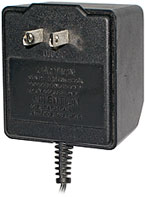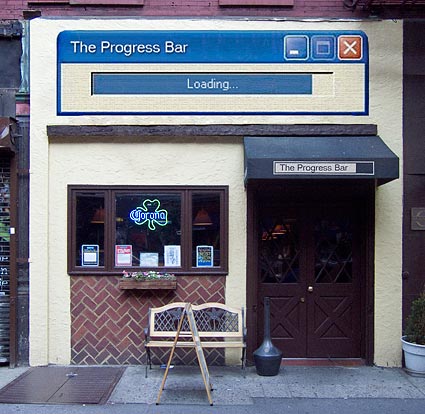Idea: Electric Outlet 2.0
The Problem:

Let’s get rid of these things once and for all.Here we are in the 21st Century, and we’re still using electric outlets designed way back in the early 20th Century. Back then, Alternating Current beat out Direct Current as the standard in our homes partly because it travels further before losing power. But our needs have changed since then. Sure, we still plug in a bunch of things that require AC, but we also have a few dozen items in each home that require DC. So each of those items has its own power-converting brick taking up precious space on our power strips, and creating eye-sores on our walls.
Some people have gotten around the problem by coming up with creative designs for power strips. But that’s backwards thinking because it just accepts that we have to deal with these bricks and puts a bandage on the problem. We can do better.
I say it’s high time we do away with the whole mess by moving the AC/DC conversion to the other side of the wall.
The Proposal
Today, if you lose an AC adapter, you have to find a new one that converts the AC in your wall to the proper voltage DC for that particular gadget. Or, you can buy a universal AC adapter for just a little more money that you can manually set to provide whatever voltage DC your gadget requires.
I propose a new standard for electric outlets where every outlet in your home has a universal adapter built in, on the other side of the wall, where you will never see it. When you need AC, it gives you AC. And when you need DC, it automatically converts to the proper voltage DC for you. No more ugly bricks. Plugging in your phone charger, computer speakers, or router will be as elegant as plugging in a lamp.
I call this new standard “Outlet 2.0.”
How will Outlet 2.0 know what kind of electricity you need?
Simple. Outlet 2.0 compliant plugs will have key-like notches in the prongs that let the outlet know what kind of electricity is needed. For example, a “Type A” plug will have zero notches. It looks like a standard plug, and it just uses normal AC. “Type B” plugs will have one notch to indicate that they require 1.5v DC. Here are a few sample plugs to illustrate what I mean:

They are given simple letter-based names so that it’s easy to remember in the event that you need to buy a replacement cord. You just look at the bottom of your gadget where it says “Requires Type G Cord” and go to Radio Shack and buy a Type G cord (at a fraction of the cost of buying a new brick). The letter is also embossed on the plug itself, so you don’t need to worry about mixing up your cords.
Won’t this increase the cost of electric outlets?
Yes. But you only need to install your outlets once. However you may otherwise buy a hundred gadgets over your lifetime that include their own transformer brick, and the cost of that brick is built into the price of the gadget. With no brick needed, the cost of the gadget goes down. Also, the weight of the new gadget in its box with all its accessories goes down, which makes it less expensive to ship, which translates to further savings.
What about power strips? How will they work?
Outlet 2.0 compliant power strips will be plugged in with a “Type A” plug so they receive AC as usual. But they will have internal universal converters at each of their outlets so they provide the proper electricity to the devices that are plugged in. Yes, this will make them slightly larger and more expensive. But the savings will come in less expensive devices, and a much neater area under your desk where everything is plugged in.
Is Outlet 2.0 backwards compatible?
Yes. Anything you have that came with a normal plug — including power bricks you got with gadgets before the Outlet 2.0 standard — will still work. They have a normal “Type A” plug, so they will receive the AC they’ve always received.
Will new 2.0 compliant plugs work in old 1.0 outlets?
Well, once the standard is adopted, it should be relatively inexpensive to replace at least some old outlets with new ones, so hopefully it won’t be an issue for long. You’ll start to see even older hotels begin to advertise that they have Outlet 2.0 compliant rooms. But if you are going to visit a home or hotel that hasn’t upgraded yet, you can bring a simple travel-size pass-through converter. You just plug it into any 1.0 outlet, and then you can plug any Outlet 2.0 compliant gadgets into the converter. (Note that any Outlet 2.0 compliant power strip will work properly in a 1.0 outlet, converting the power as needed).
What if a 2.0 plug is plugged into a 1.0 outlet without an adapter?
 This could damage your gadget, so there is a feature in the Outlet 2.0 standard that prevents this from happening. It is not shown in the plug renderings above because I haven’t worked out the details yet. It will probably take the form of an extra prong that doesn’t carry electricity, placed off center so as not to be confused with the grounding prong already present on current “three-prong” plugs. At right is a rendering of how it may appear. This not only prevents you from sticking a 2.0 plug in a 1.0 outlet, but makes the different outlets easy to recognize by sight.
This could damage your gadget, so there is a feature in the Outlet 2.0 standard that prevents this from happening. It is not shown in the plug renderings above because I haven’t worked out the details yet. It will probably take the form of an extra prong that doesn’t carry electricity, placed off center so as not to be confused with the grounding prong already present on current “three-prong” plugs. At right is a rendering of how it may appear. This not only prevents you from sticking a 2.0 plug in a 1.0 outlet, but makes the different outlets easy to recognize by sight.
Will I have to upgrade my whole house to Outlet 2.0?
No. If you’ve had the lamp in the corner plugged into the same 1.0 outlet for the past 20 years, and you never plug anything else into it, there’s no need to upgrade that outlet. Just upgrade the outlets where you will benefit from having the Outlet 2.0 standard. If you ever sell the house, you may consider a full upgrade then so you can advertise that every room is Outlet 2.0 compliant.
Conclusion
For far too long, we’ve been dealing with heavy, unwieldy, ugly power conversion bricks all over the place, and they don’t seem to be going anywhere soon. But I refuse to believe that a world that sends robots to Mars can’t figure out a way to solve this problem. So this is my proposal. Of course, I’m not an electric engineer, so I may be missing some of the finer issues. Let me know what you think, and tell me how this idea can be improved.
Update: There are few things more frustrating for me than discovering that one of my ideas has already been thought of. But in this case I’m pleased to find via the comments that a similar proposal is already being worked on called The Green Plug. It doesn’t appear that the Green Plug puts the converter on the wall side, but it does create something like the Outlet 2.0 Power Strip, so that all your devices can share the same DC converter. I fully support this.











 There are a handful of artists out there making incredibly detailed
There are a handful of artists out there making incredibly detailed 
 Each company could pick one artist each year whose work exemplifies the company’s brand or ethos, provide financing for a year during which the artist develops a body of work, and then offer a performance or exhibition space — perhaps in a flagship store or corporate headquarters — to showcase the result.
Each company could pick one artist each year whose work exemplifies the company’s brand or ethos, provide financing for a year during which the artist develops a body of work, and then offer a performance or exhibition space — perhaps in a flagship store or corporate headquarters — to showcase the result.